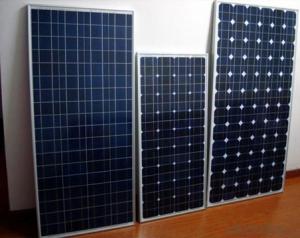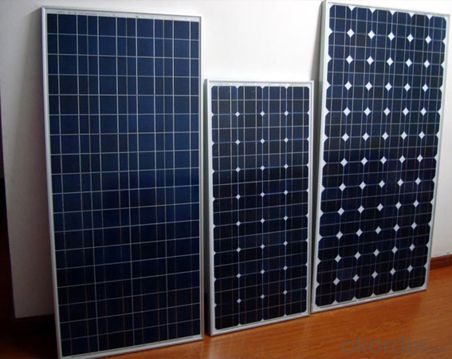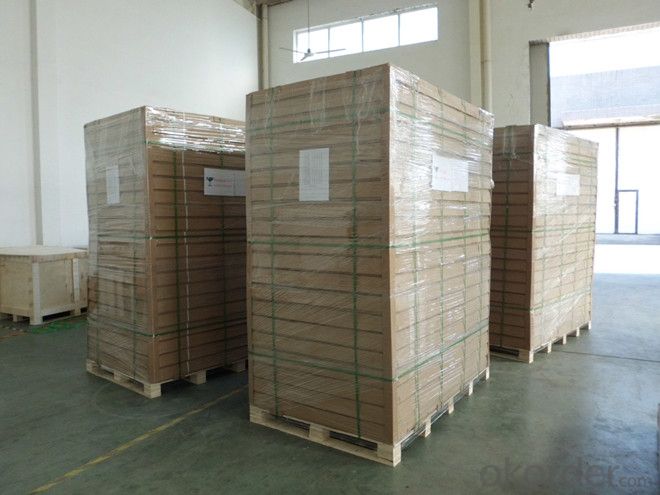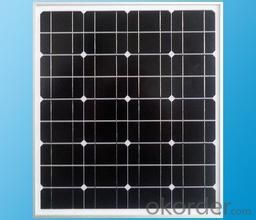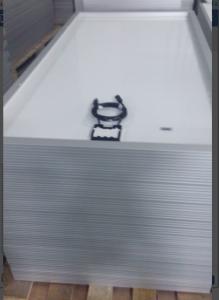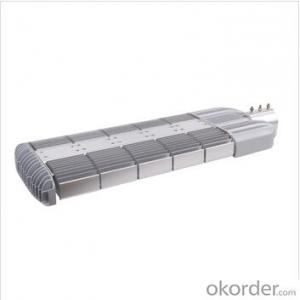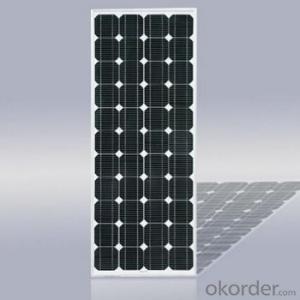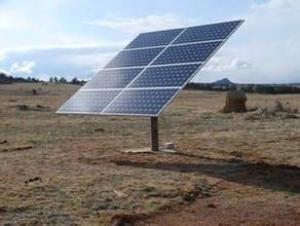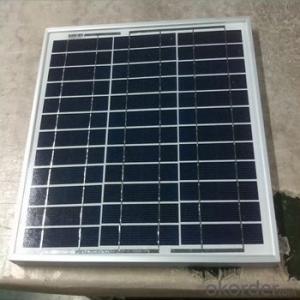Ub Solar Panels - CNBM Series Monocrystalline Solar Panels
- Loading Port:
- Shanghai
- Payment Terms:
- TT OR LC
- Min Order Qty:
- 1 pallet
- Supply Capability:
- 100000000 pallet/month
OKorder Service Pledge
OKorder Financial Service
You Might Also Like
CNBM Series Monocrystalline Solar Panels
Solar modules use light energy (photons) from the sun to generate electricity through the photovoltaic effect. The majority of modules use wafer-based crystalline silicon cells or thin-film cells based on cadmium telluride or silicon. The structural (load carrying) member of a module can either be the top layer or the back layer. Cells must also be protected from mechanical damage and moisture. Most solar modules are rigid, but semi-flexible ones are available, based on thin-film cells.
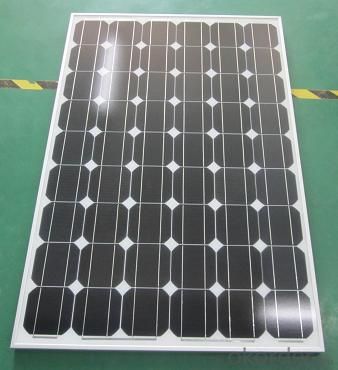
Introduction of Solar Monocrystalline Series Panels
CNBM Solar photovoltaic (PV) Panel is designed for large electrical power requirements. It is the optimal choice for both on-grid and off-grid power systems. CNBM Solar panel offers high performance of power per square foot of solar array. Monocrystalline silicon(c-Si): often made using the Czochralski process. Single-crystal wafer cells tend to be expensive, and because they are cut from cylindrical ingots, do not completely cover a square solar cell module without a substantial waste of refined silicon. Hence most c-Si panels have uncovered gaps at the four corners of the cells.
Characteristics of Solar Monocrystalline Series Panels
I Solar Cell : High efficiency crystalline solar cell. Even if under the weak light, the solar module can produce maximum power output.
II Tempered glass (toughened glass): Anti-reflecting coating and high transmission rate glass increase the power output and mechanical strength of solar module.
III EVA and TPT: Using high quality EVA and TPT to prevent destroying and water.
IV AI frame: Without screw, corner connection. 6 holes on the frame can be installed easily.
V Junction box: Multi function junction box with water proof.
VI Long lifetime: ≥25 years; Less power decrease
VII Good performance of preventing from atrocious weather such as wind and hails.
VIII Resisting moisture and etching effectively, not effected by geology.
Standard Test Conditions of Solar Monocrystalline Series Panels
The opto-electrical specifications shown below are stabilized values being measured at Standard Test Conditions, Irradiance: 1000W/m2, Spectrum: AM1.5 at 25°C, The info below is subject to manufacturing tolerances. Where appropriate minutes of measurement are available and are used for the dimensioning of the installation.
Advantages of Solar Monocrystalline Series Panels
• CNBM Solar performance guarantees for 25 years
• 12 years guarantee for workmanship
• Timeliness of delivery
CNBM International Corporation's products including Monocrystalline Solar Panel, Polycrystalline Solar Panel have received and enjoyed famous reputation in many countries and regions in the world .As a solar panel supplier in China, we strive to provide our customers with excellent service, superior products and unmatched value.
Characteristics of Solar Monocrystalline Series Panels
Max Power Voltage Vmp (V) | 18.4V | 17.6V |
Max Power Current Imp (A) | 6.52A | 7.39A |
Open Circuit Voltage Voc (V) | 23.0V | 22.2V |
Short Circuit Current Isc (A) | 6.97A | 7.90A |
Max Power Pm (W) | 120W | 130W |
Temperature Coefficient of Cells
NOCT | 47℃±2℃ |
Temperature Coefficients of Isc (%/℃) | 0.064 |
Temperature Coefficients of Voc (%/℃) | -0.33 |
Temperature Coefficients of Pmp (%/℃) | -0.45 |
Mechanical Data Solar Monocrystalline Series
Power | 120W/130W |
Dimension | 1190/1470×670×30mm |
Weight | 9.5kg/11.7kg |
Tolerance | ±3% |
The dimension of the modules can be changed according to the demand of clients
Limits
Operating Temperature | –40 °C to +85°C |
Storage Temperature | –40 °C to +85°C |
Max System Voltage | 700V |
Guarantee Solar Monocrystalline Series Panels
Products Guarantee | 10 yrs free from defects in materials and workmanship |
Performance Guarantee | No less than 90% within 10yrs and no less than 80% within 25yrs |
Certificates | IEC, ISO, TUV, CE |
FAQ
We have organized several common questions for our clients,may help you sincerely:
1. What’s price per watt?
A: It’s depends on the quantity, delivery date and payment terms of the order. We can talk further about the detail price issue. Our products is high quality with lower price level.
2. Can you tell me the parameter of your solar panels?
We have different series of cells with different power output, both from c-si to a-si. Please take our specification sheet for your reference.
3. How do you pack your products?
We have rich experience on how to pack the panels to make sure the safety on shipment when it arrives at the destination.
4. Can you do OEM for us?
Yes, we can.
5. How long can we receive the product after purchase?
In the purchase of product within three working days, We will arrange the factory delivery as soon as possible. The perfect time of receiving is related to the state and position of customers. Commonly 7 to 10 working days can be served.
- Q: Are there any disadvantages to using solar panels?
- Yes, there are a few disadvantages to using solar panels. Firstly, the initial installation cost of solar panels can be quite high, which may deter some people from adopting this technology. Additionally, solar panels require a significant amount of space for installation, making them impractical for individuals with limited rooftop or land availability. Furthermore, solar panels are dependent on sunlight, so their efficiency can be affected by factors such as weather conditions and geographical location. Finally, the production process of solar panels involves the use of certain chemicals and materials that can have negative environmental impacts if not properly managed.
- Q: I need to use solar panels to charge lead acid batteries in an off-grid application. I understand that solar panels have a open circuit maximum voltage and an maximum amperage under no resistance, and that one can optimize the power output by regulating the load (resistance). If so, is just connecting 2 -volt solar panels to a lead-acid battery inefficient? Are there devices that will maximize 2 volt output power (by varying the resistance)? Am I on the right track here? Thanks for any help.
- The answer is actually quite complicated, but if you're planning on building just a very small system, most likely, the panel will be small and weak. In this case, connecting a panel that is 8 volts open circuit directly to a lead-acid battery is probably the most efficient way to charge. There are charge controllers that you can buy, some of which actively track the maximum power point for charging your battery. Unfortunately, those controllers might eat 5 or 0 watts, just to get you another few percent of charging efficiency. If your panel is only 50 watts in the first place, you can see that this is not a good deal. If you're getting serious panels (clue: price $500 each), then you may very well benefit from a charge controller with MPPT (max power point tracking). Lead-acid, either a flooded cell like your car battery, or AGM, are the standard for solar energy storage. Lithium ion is better in many ways, being less sensitive to temperature, state of discharge, and they are also lighter. Charging them is also more straightforward with the right circuitry. The problem is, they cost like $500 per kWh, compared with less than a tenth that price for lead-acid.
- Q: Please tell me what they are made of and how the materials help the solar cell produce electricity. Im doing a science projects so i need help on knowing all this info. Its a debate, so i need correct information please.I will please need more information about the bad things about solar energy and solar panels. Please say what solar panels do to create pollution or do anything that is not friendly to the environment. If you want just give me a website. Thank you
- image voltaic cells paintings for the period of the photoelectric effect. Incoming photons knock out electrons of the textile, which being a semiconductor helps a small ability distinction. close to to the sunlight, each and everything could be very severe (like a Van Halen gig), radiation, energetic ions, magnetic fields, the works. of direction, NASA project planners could take all those issues into consideration. i ask your self what textile maintains to be stable at 5800? ok (or perhaps it fairly is not needed), and captures all photons of all energies, to be one hundred% powerful. The link provided by making use of Snow Blossom is extremely thrilling. I do in simple terms no longer look waiting to study the secondary link Thermophotovoltaics. Edit: image voltaic Flares may well be a difficulty. they're by making use of and great unpredictable, upward push for hundreds of miles, achieving hundreds of thousands of Kelvin.
- Q: Can solar panels be installed on a telecommunications tower or antenna?
- Yes, solar panels can be installed on a telecommunications tower or antenna. This can help provide a reliable and sustainable source of energy for powering the tower's equipment and reducing its dependence on traditional energy sources.
- Q: I have a 2 volt deep cylce Everstart battery with 845 cranking amps, and a Grape Solar GS-S-250-Fab5 250-Watt Monocrystalline Solar Panel . I use them to power a 48Flat screen TV, a Roku, my 65 watt consuming MacBook Pro, and a 65 watt Fan.I know from previous experience that just the battery, an inverter, and the fan, that the fan will blow for 0 hours straight.Should I really be concerned with a Charge Controller?
- Should I really be concerned with a Charge Controller? Yes. The main purpose of the charge controller is to protect the battery from over charging. Over charging reduces battery life. And spending extra money for a MPPT type controller will get more more useable power out of your solar panel. Would another battery of the same magnitude be helpful in preventing an accident? How much storage capacity does your current battery have (measured in kWH)? A ~$20 Kill-a-Watt meter would take a lot of uncertainty out of how much power you actually use. Even deep cycle batteries suffer reduced battery life from deep discharges. The battery sounds too small for the loads you describe so I would think you would want more. ---------------------------------------... After reading the other answer In a nutshell, with your small 2 volt starting battery, 24 volt panel and a mix of unknown loads, (which is correct), I thought I would elaborate. I had not considered the possibility that you bought a 24 volt panel for your 2 volt battery. Hooking the panel you bought directly to the current battery is a horrible idea. I you were lucky it would just cook the battery in a short period of time. You basically bought the wrong type of panel for a 2 volt system. I assume that there are no controllers on the the market for this situation. If that's the case, I don't know of any good way match the 24v panel to the 2 volt battery.
- Q: Can solar panels be installed on a sports stadium?
- Yes, solar panels can be installed on a sports stadium.
- Q: How much candle lights is required to operate a 205 watt solar panel?
- That's hard to tell. A solar panel produces somewhere between 7 and 0W per square foot under sunlight exposure. You should calculate the light intensity of sunlight, and then calculate the light intensity of a candle (You'll have to look that up in some physics book or the internet) and then just multiply the number of candles until you match the intensity of sunlight. Realistically, you would need so many candles that you wouldn't be able to fit them in front of the solar panels, assuming you don't end up with a huge fireball.
- Q: Solar panel for battary charging
- What you are stating is that the battery you have will operate the UPS for about 2 hours before it is drained past the point of no return (technically 2.82 hours, but that would be a dead battery - most well-designed UPS systems cut off when the battery gets below about a 30% charge so that battery is not damaged. Lead-Acid batteries have about a 0%/month self-discharge rate if there is no load connected. The very best systems are as low as 3%, the worst are over 20% - and all at a 'normal' temperature. So, you will need a maintenance charger of about ten (0) watts or so - amp will be more than enough. And about any solar panel will handle that much with the proper charging connection.
- Q: Can solar panels be used in areas with high levels of electromagnetic interference?
- Yes, solar panels can be used in areas with high levels of electromagnetic interference. However, it is important to ensure proper grounding and shielding techniques are implemented to minimize the impact of electromagnetic interference on the performance and efficiency of the solar panels.
- Q: Can solar panels be installed on train stations?
- Yes, solar panels can be installed on train stations. In fact, many train stations around the world are adopting solar energy systems to power their operations and reduce their carbon footprint. Solar panels are installed on the roofs or canopies of train stations to harness sunlight and generate electricity, which can be used for lighting, heating, cooling, and other station facilities. This renewable energy source makes train stations more sustainable and helps in the transition towards a greener transportation system.
Send your message to us
Ub Solar Panels - CNBM Series Monocrystalline Solar Panels
- Loading Port:
- Shanghai
- Payment Terms:
- TT OR LC
- Min Order Qty:
- 1 pallet
- Supply Capability:
- 100000000 pallet/month
OKorder Service Pledge
OKorder Financial Service
Similar products
Hot products
Hot Searches
